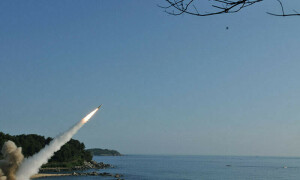WASHINGTON: The only international issue to raise a ripple in Australia’s election campaign has been Syria, which Prime Minister Kevin Rudd tried to exploit to highlight opponent Tony Abbott’s inexperience in world affairs. That’s unfortunate, because the most critical choice facing Australians on Saturday isn’t between Rudd and Abbott. It’s between the United States and China.
Nothing matters more to Australia’s long-term future than managing this increasingly difficult balancing act between the world’s two strongest states. If Abbott wins — and the polls are unanimous that he will — how he navigates between Australia’s strongest ally and its biggest trading partner will determine the fate of his government and his country.
This is a new kind of challenge for Canberra. For decades Australian leaders have relied on the US to keep Asia stable and their country safe, and in return they’ve given Washington unconditional support in the region and beyond. This worked fine as long as US leadership was welcomed throughout Asia, including by the biggest customers for Australia’s goods and natural resources. That’s now changing.
For the first time in centuries, China will soon again boast the world’s biggest economy. Ultimately wealth is power, which means that China now poses the most serious challenge to Western power in Asia since Europeans settled Australia.
At the same time China has become the essential locomotive for Australia’s economy. In the second quarter of this year, China bought more than 35 per cent of Australia’s exports — double the proportion from five years ago. More of our coal and iron ore, and more of our produce, goes to the mainland than anywhere else. “Not since the wool boom of 1950,” the Australian Financial Review noted a few weeks ago, “has Australia been so reliant on a single trade relationship.”
Any tensions remained latent until the global financial crisis, when China started overtly challenging US primacy in Asia and pushing for a bigger share of regional leadership. Since then, the rivalry has escalated sharply. The US responded to China’s challenge with President Barack Obama’s “pivot” to Asia, and China in turn has pushed back with increased assertiveness over territorial disputes.
Australia is caught up in this growing rivalry. On the one hand, the U.S. has been determined to reaffirm Australia’s support. Eighteen months ago, Obama delivered his major speech on the pivot in Canberra, at the same time announcing that U.S. Marines would deploy to Darwin — the first time US combat forces have been based in Australia since World War II.After China made its displeasure at these moves plain, Canberra tacked back the other way. Australia has retreated from any further US military basing, and tiptoed around Beijing’s sensitivities in a defence policy paper released this year. As a reward China has dubbed Australia a “strategic partner.”
Australia’s leaders — from both camps — are in denial about where this is leading. They endlessly assert that “Australia does not have to choose between America and China.” Certainly they do not want to make this choice. Australia’s hopes for a secure and prosperous future absolutely depend on its ability to keep both its major alliance and its primary trading relationship in good order.
But the choices Australia has to make depend of course not on what Canberra wants but on what the US and China decide. Any direct armed clash between them — not a remote possibility over the Senkaku/Diaoyu islands, for example — would create immense pressure from both sides, with the US expecting Australia to join the fight, and China insisting it keep away. Disaster would loom, whichever choice was made.
Australia’s only hope for avoiding such disasters, and ensuring a peaceful and secure future, depend on the US and China settling their differences and finding a new, stable basis for their relationship. The hard realty of China’s new power means that this will only happen if the US is willing to accommodate some of China’s ambitions for a bigger regional role.
This need not, and should not, mean conceding primacy in Asia to China. But it does mean the US should be willing to share leadership in Asia with China, if China is willing to do the same. And it means that Australia should be urging the US to do precisely this kind of deal with China.
This is not an idea that anyone in Australia is comfortable with, but it is much better than the only credible alternative, which is to be drawn as an American ally into a bitter and dangerous rivalry with China that the US ultimately cannot win.
This is the choice that will confront Abbott if he wins. As a committed conservative, Abbott has the instinct to support the US through thick and thin. But he also has a strong streak of pragmatism, as his cautious and sceptical approach to the crisis in Syria has shown. And, as a conservative, Abbott has less to prove, and less to fear politically, from an approach that puts some distance between Canberra and Washington.
Abbott might surprise everyone, including himself, by taking on the challenge of navigating Australia through the shifting strategic tides of the Asian Century. If so, his first step has to be to start talking frankly to Washington about how Australia sees the American role in Asia.
The message is simple enough. Australia wants the US to remain a major power in Asia, but not on the basis of escalating rivalry with China. So the US should try to define its future role in terms China is willing to accept, if that is at all possible. This won’t be a welcome message in Washington, but leaders there will see Abbott as a close friend. And what are close friends for?
By arrangement with the Washington Post/Bloomberg News Service








































Dear visitor, the comments section is undergoing an overhaul and will return soon.